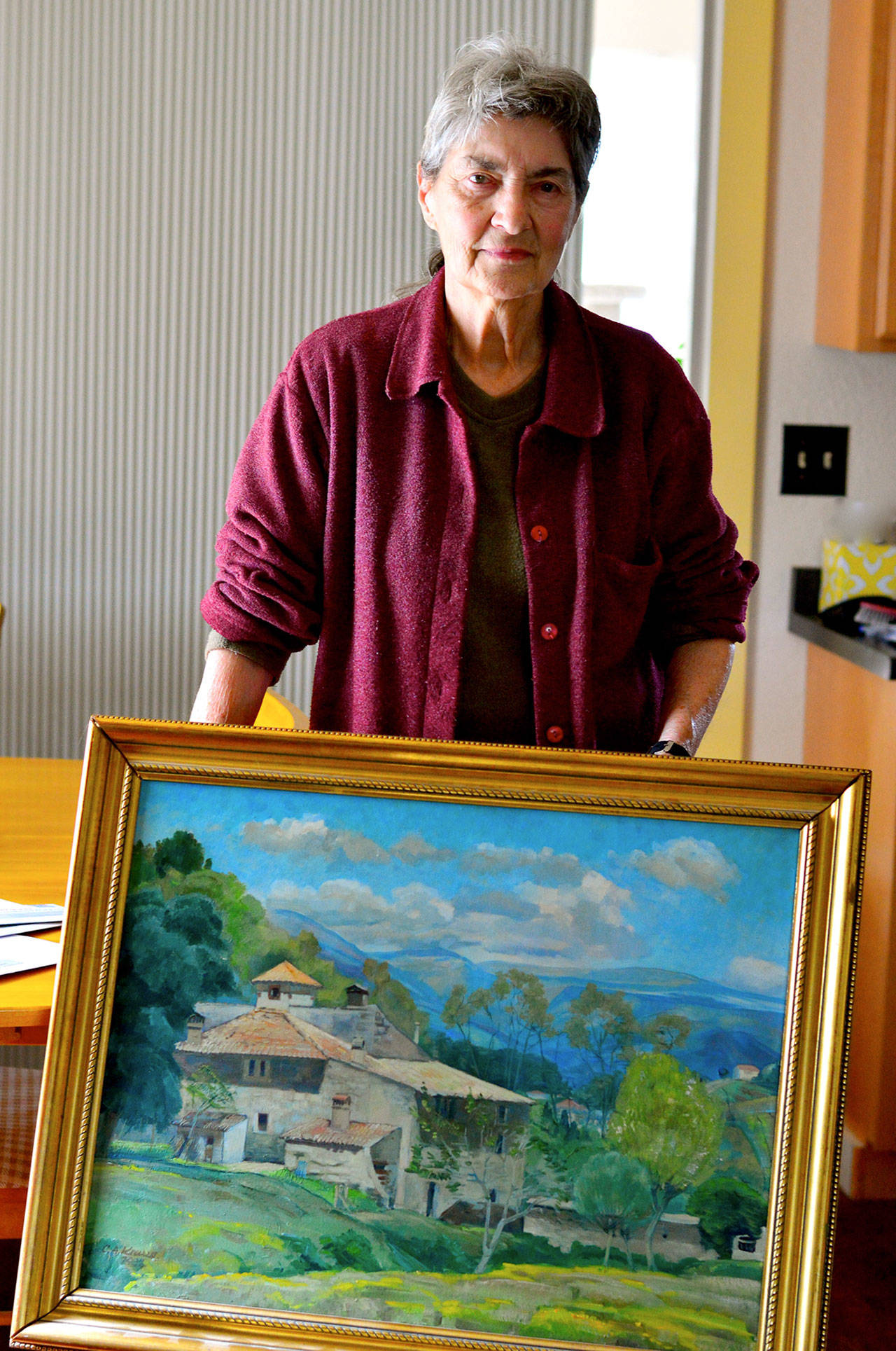PORT TOWNSEND — The 1931 oil painting traveled with Joy Qualey from house to house, state to state.
A serene scene of the South of France, it was a mystery. A family friend had given it to Qualey’s mother, and — years later — no one could tell her about the artist, Carl Arthur Krauss, or his circumstances.
At 82, Qualey lives in a house filled with art — her own father, Thomas Harry Klopp, was a painter — but she’s been wanting to downsize a bit. So Qualey gives gifts from her trove of art and craft pieces to friends.
She wanted to find a home for Krauss’ painting, with its brittle slip of paper bearing the title “Les Milles, Aix-en-Provence,” and wondered if she could ever find someone connected to the artist.
“This [painting] has plagued me for years,” Qualey said.
Her thought for some time now was that she shouldn’t have it in her possession.
By choice, Qualey does not use the Internet. What she does have are friends such as Bruce Cowan.
Qualey is a tenor saxophonist, Cowan a guitarist and ukulelist; the two have played in various local bands for years.
Cowan, an avid researcher and European traveler, began looking around some time ago for traces of Krauss. He even inquired in person at a gallery in Avignon, France, not far from where “Les Milles” was painted.
That yielded no leads.
Then, last month, Cowan gave it another go online.
“I stumbled onto this stuff from Hirschhorn,” he said, noting the German town along the Neckar River.
There, a woman named Evelyn Christoffers had a museum exhibition of her art in summer 2015. She’d shared the show with another painter, Carl Arthur Krauss. He was her late grandfather, the man who had raised her and encouraged her to paint.
Works from late in his career, when he lived in Steinheim am Main, Germany, were displayed alongside Christoffers’.
Krauss had died in 1973 at age 80, and he had traveled to the United States and spent time in New Mexico. That may have been where Qualey’s family friend acquired the painting.
Cowan learned, too, that Krauss was part of the art scene in Dresden, Germany, which was known as the Florence of the north. He had come from gentry, his father a Saxon court councilor and state parliament director.
Instead of an official career, the younger Krauss chose the life of an artist, and he went to the South of France, where hillsides were green and sunlight golden, to spend part of the early 1930s painting.
Then, in 1939, Hitler and the Nazi army began their march across Europe.
By the depths of World War II, Krauss was working in his two studios in Dresden. The locality was the target of a saturation bombing by the Allied Forces in mid-February 1945.
Most of Krauss’ body of work, some 500 original paintings, burned up in the fires that destroyed the city.
Flush with information about the artist, Cowan emailed Christoffers in Hirschhorn. She quickly responded: “Yes I am indeed the granddaughter of the Dresden art painter Carl Arthur Krauss,” whose works were part of that exhibition five years ago.
Titled “Kontraste,” the Hirschhorn show highlighted the similarities and differences between the grandfather and granddaughter’s style.
Next Cowan told Qualey he’d found the person she’d been looking for. All they needed was someone who spoke German and could serve as interpreter.
Qualey’s neighbor and friend Karli had lived in Germany for years and told Qualey it would be no problem to email Christoffers and get her address.
At first, “I kind of panicked; I’ve got to send this off to Germany,” Qualey said.
After she’d had a chance to think, she became eager to do exactly that.
“I didn’t want to waste any time,” she said. “You never know.”
Karli and Christoffers arranged a phone call for March 8 to confirm the mailing address in Hirschhorn. Four days later, Qualey drove the painting to Mail Plus in Port Townsend and had it packed up and shipped to Germany. The cost: a little more than $400.
Which was a shock, yes. But Qualey, who has been careful with her finances and said she is fortunate to be comfortable in her little house, was ultimately fine with it.
“I’ve wanted this for so long,” Qualey said, adding she’s glad she got the painting sent off before the deepening of the coronavirus pandemic.
These days, she’s staying home, gardening and watching the news, “unbelievable” as it is.
“I never thought I’d live to see anything like this,” she said.
Qualey noted that Krauss and her own father were artists of the same generation; kindred souls, perhaps.
That is another reason why she wanted to return the painting to Germany.
Family friends and acquaintances made sure she got the art created by her late father, she added.
“To me,” Qualey said, “the only way to live life is the golden rule” of doing for others what you hope they will do for you.
“That is all you need.”
________
Diane Urbani de la Paz, a former features editor for the Peninsula Daily News, is a freelance writer living in Port Townsend.

